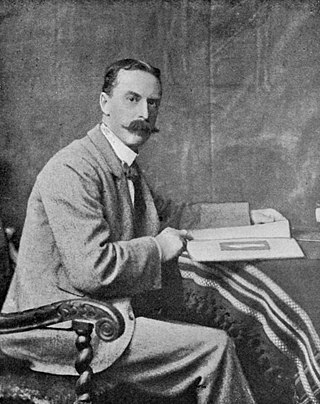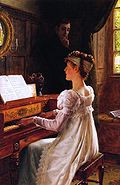Edmund Leighton
British painter (1852–1922) From Wikipedia, the free encyclopedia
Edmund Blair Leighton ROI (21 September 1852 – 1 September 1922) was an English painter of historical genre scenes, specialising in Regency and medieval subjects. His art is associated with the pre-Raphaelite movement of the mid-to-late nineteenth and early twentieth centuries.[1]
Biography
Summarize
Perspective
Leighton was the son of the artist Charles Blair Leighton (1823–1855) and Caroline Leighton (née Boosey). He was educated at University College School, leaving at 15 to work for a tea merchant. Wishing to study art, he went to evening classes in South Kensington and then to the Heatherley School of Fine Art in Newman Street, London. Aged 21, he entered the Royal Academy Schools.[2][3] Among his first commissions were monochrome illustrations for Cassell's Magazine and its Book of British Ballads.[3] His first painting to be exhibited at the Royal Academy was A Flaw in the Title in 1874; it sold for £200. He soon gave up "black and white" illustrations, working for the rest of his career in oil on canvas.[3] He married Katherine Nash in 1885; they had a son, the painter Edmund J. Blair Leighton, and a daughter. He exhibited annually at the Royal Academy until 1920.
Leighton was a fastidious craftsman, producing highly finished, decorative historical paintings. These were romanticised scenes, often of chivalry and women in medieval dress with a popular appeal.[4] It would appear that he left no diaries, and though he exhibited at the Royal Academy for over forty years, he was never an Academician or an Associate.
Works
Summarize
Perspective
- Old Times (1877)[5]
- Till Death Do Us Part (1878)
- Faded Laurels (1889)
- Lady Godiva (1892)[6]
- The Elopement (1893)
- My Next-Door Neighbour (1894)
- In 1816 (1895)
- In Time of Peril (1897)[4]
- Off (1899)[8]
- On the Threshold (1900)[9]
- God Speed! (1900)
- The Accolade (1901)[6]
- Tristan and Isolde or The End of the Song (1902)
- Courtship (1903)
- The Queen kisses the sleeping poet Alain Chartier (1903)[10]
- Courtship by the Piano (1903)
- Ribbons and Laces for Very Pretty Faces (1904)
- The Dedication (1908)
- To the Land Unknown (1911)
- Stitching the Standard (1911)[11]
- The Boyhood of Alfred the Great (1913)
- My Fair Lady (1914)
- The Charity of Elisabeth of Hungary (1915)
- The Hostage (1912)
Among Leighton's other works are:
- Un Gage d'Amour (1881), Auckland Art Gallery Toi o Tamaki.[12]
- Conquest (1884)[13]
- The Rehearsal (1888), Croydon Clocktower, UK.[6]
- How Liza Loved the King (1890), Towneley Hall Art Gallery and Museum, Burnley.[6]
- Waiting for the Coach (1895), Manchester Art Gallery.[14]
- On the Threshold (1900), Manchester Art Gallery.[9]
- The Accolade (1901), private collection.[6]
- Adieu (1901), Manchester Art Gallery.[15]
- The Shadow (1909), City Hall, Cardiff[16]
- A Nibble (1914), private collection.[6]
- An Arrival (1916), City Hall, Cardiff[16]
- The Lord of Burleigh, Tennyson (1919), private collection.[6]
- Sweet Solitude (1919), private collection.[6]
- After Service (1921), private collection.[17]
- Signing the Register (undated), Bristol City Museum and Art Gallery.[6]
- The Fond Farewell (1891), Messum's, London.[6]
- Lord of the Manor (undated), private collection.[6]
- Sorrow and Song (undated), Bristol City Museum and Art Gallery.[6]
References
Bibliography
External links
Wikiwand - on
Seamless Wikipedia browsing. On steroids.



























